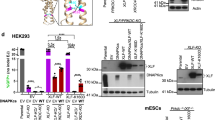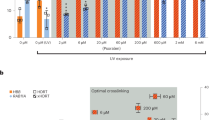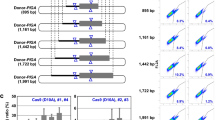Abstract
Triple helix forming oligonucleotides (TFOs) recognize and bind sequences in duplex DNA and have received considerable attention because of their potential for targeting specific genomic sites 1, 2, 3 . TFOs can deliver DNA reactive reagents to specific sequences in purified chromosomal DNA (ref. 4 ) and nuclei 5 . However, chromosome targeting in viable cells has not been demonstrated, and in vitro experiments indicate that chromatin structure is incompatible with triplex formation 6, 7, 8 . We have prepared modified TFOs, linked to the DNA-crosslinking reagent psoralen, directed at a site in the Hprt gene. We show that stable Hprt -deficient clones can be recovered following introduction of the TFOs into viable cells and photoactivation of the psoralen. Analysis of 282 clones indicated that 85% contained mutations in the triplex target region. We observed mainly deletions and some insertions. These data indicate that appropriately constructed TFOs can find chromosomal targets, and suggest that the chromatin structure in the target region is more dynamic than predicted by the in vitro experiments.
This is a preview of subscription content, access via your institution
Access options
Subscribe to this journal
Receive 12 print issues and online access
$209.00 per year
only $17.42 per issue
Buy this article
- Purchase on Springer Link
- Instant access to full article PDF
Prices may be subject to local taxes which are calculated during checkout



Similar content being viewed by others
References
Chubb, J.M. & Hogan, M.E. Human therapeutics based on triple helix technology. Trends Biotechnol. 10, 132–136 (1992).
Thuong, N. & Helene, C. Sequence specific recognition and modification of double helical DNA by oligonucleotides. Angew. Chem. Int. Ed. Engl. 32, 666–690 (1993).
Neidle, S. Recent developments in triple helix regulation of gene expression. Anti-Cancer Drug Design 12, 433–442 (1997).
Strobel, S.A., Doucette-Stamm, L.A., Riba, L., Houseman, D.E. & Dervan, P.B. Site specific cleavage of human chromosome 4 mediated by triple helix formation. Science 254, 1639–1642 (1991).
Giovannangeli, C., Diviacco, S., Labrousse, V., Gryaznov, S., Charneau, P. & Helene, C. Accessibility of nuclear DNA to triplex forming oligonucleotides: the integrated HIV-1 provirus as a target. Proc. Natl Acad. Sci. USA 94, 79–84 (1997).
Espinas, M.L., Jimenez-Garcia, E., Martinez-Balbas, A. & Azorin, F. Formation of triple stranded DNA at d(GA-TC)n sequences prevents nucleosome assembly and is hindered by nucleosomes. J. Biol. Chem. 271, 31807–31812 (1996).
Westin, L., Blomquist, P., Milligan, J.F., & Wrange, O. Triple helix DNA alters nucleosomal histone-DNA interactions and acts as a nucleosomal barrier. Nucleic Acids Res. 23, 2184–2191 (1995).
Brown, P.M. & Fox, K.R. Nucleosome core particles inhibit triple helix formation. Biochem. J. 319, 607–611 (1996).
Wang, G., Levy., D.D., Seidman, M.M. & Glazer, P. Targeted mutagenesis in mammalian cells mediated by intracellular triple helix formation. Mol. Cell. Biol. 15, 1759–1768 (1995).
Rossiter, B.J.F., Fuscoe, J.C., Muzny, D.M., Fox, M. & Caskey, C.T. The chinese hamster hprt gene: Restriction map, sequence analysis, and multiplex detection screen. Genomics 9, 247–256 (1991).
Schneider, T.D. Sequence walkers: a graphical method to display how binding proteins interact with DNA or RNA sequences. Nucleic Acids Res. 25, 4408–4415 (1997).
Cariello, N. & Skopek,T.R. Analysis of mutations occurring at the human hprt locus. J. Mol. Biol. 231, 41–57 (1993).
Griffin, L.C. & Dervan, P.B. Recognition of thymidine-adenine base pairs by guanine in a pyrimidine triple helix motif. Science 245, 967–971 (1989).
Fossella, J.A., Kim, Y.J., Shih, H., Richards, E.G. & Fresco, J.R. Relative specificities in binding of Watson Crick base pairs by third strand residues in a DNA pyrimidine triplex motif. Nucleic Acids Res. 21, 4511–4515 (1993).
Korshun, V.A. et al. New pyrene derivatives for fluorescent labeling of oligonucleotides. Nucleosides and Nucleotides 16, 1461–1464 (1997).
Orson, F.M., Kinsey, B.M. & McShan, W.M. Linkage structures strongly influence the binding cooperativity of DNA intercalators conjugated to triplex forming oligonucleotides. Nucleic Acids Res. 22, 479–484 (1994).
Koshlap, K.M., Gillespie, P., Dervan, P.B. & Feigon, J. Nonnatural deoxyribonucleosides D3 incorporated in an intramolecular DNA triplex binds sequence specifically by intercalation. J. Am. Chem. Soc. 115, 7908–7909 (1993).
Kukreti, S., Sun, J.S., Garestier, T. & Helene, C. Extension of the range of DNA sequences available for triple helix formation: stabilization of mismatched triplexes by acridine containing oligonucleotides. Nucleic Acids Res. 25, 4264–4270 (1997).
Cariello, N.F. Software for the analysis of mutations at the human hprt locus. Mutat. Res. 312, 173–185 (1994).
Laquerbe, A., Moustacchi, E. & Papadopoulo, D. Genotoxic potential of psoralen crosslinks versus monoadducts in normal human lymphoblasts. Mutat. Res. 346, 173–179 (1995).
Kunkel, T.A. Biological asymmetries and the fidelity of eukaryotic DNA replication. Bioessays 14, 303–308 (1992).
Sargent, R.G., Brenneman, M.A. & Wilson, J.H. Repair of site specific double strand breaks in a mammalian chromosome by homologous and illegitimate recombination. Mol. Cell. Biol. 17, 267–277 (1997).
Thacker, J., Chalk, J., Ganesh, A. & North, P. A mechanism for deletion formation by human cell extracts: the involvement of short sequence repeats. Nucleic Acids Res. 20, 6183–6188 (1992).
Phillips, J.W. & Morgan, W.F. Illegitimate recombination induced by DNA double strand breaks in a mammalian chromosome. Mol. Cell. Biol. 14, 5794–5803 (1994).
Wang, G., Seidman, M.M. & Glazer, P.M. Mutagenesis in mammalian cells induced by triple helix formation and transcription coupled repair. Science 271, 802–805 (1996).
Escude, C. et al. Stability of triple helices containing RNA and DNA strands: experimental and molecular modeling studies. Nucleic Acids Res. 21, 5547–5553 (1993).
Posvic, T.J. & Dervan, P.B. Triple helix formation by oligonucleotides on DNA extended to the physiological range. J. Am. Chem. Soc. 111, 3059–3061 (1989).
Lee, J.S., Woodsworth, M.L., Latimer, L.J.P., & Morgan, A.R. Poly(pyrimidine):poly(purine) synthetic DNAs containing 5-methylcytosine form stable triplexes at neutral pH. Nucleic Acids Res. 12, 6603–6614 (1984).
Gilar, M., Belenky, A., Smisek, D.L., Bourque, A. & Cohen, A.S. Kinetics of phosphorothioate oligonucleotide metabolism in biological fluids. Nucleic Acids Res. 25, 3615–3620 (1997).
Agrawal, S. et al. Mixed backbone oligonucleotides as second generation antisense oligonucleotides: In vitro and in vivo studies. Proc. Natl Acad. Sci. USA 94, 2620–2625 (1997).
Author information
Authors and Affiliations
Corresponding author
Rights and permissions
About this article
Cite this article
Majumdar, A., Khorlin, A., Dyatkina, N. et al. Targeted gene knockout mediated by triple helix forming oligonucleotides. Nat Genet 20, 212–214 (1998). https://doi.org/10.1038/2530
Received:
Accepted:
Issue Date:
DOI: https://doi.org/10.1038/2530
This article is cited by
-
Nanoparticles that deliver triplex-forming peptide nucleic acid molecules correct F508del CFTR in airway epithelium
Nature Communications (2015)
-
Inhibition of transcription by platinated triplex-forming oligonucleotides
JBIC Journal of Biological Inorganic Chemistry (2012)
-
Exploring the reasons for the large density of triplex-forming oligonucleotide target sequences in the human regulatory regions
BMC Genomics (2006)
-
Mismatch repair participates in error‐free processing of DNA interstrand crosslinks in human cells
EMBO reports (2005)
-
Targeted activation of transcription in vivo through hairpin-triplex forming oligonucleotide in Saccharomyces cerevisiae
Molecular and Cellular Biochemistry (2005)



